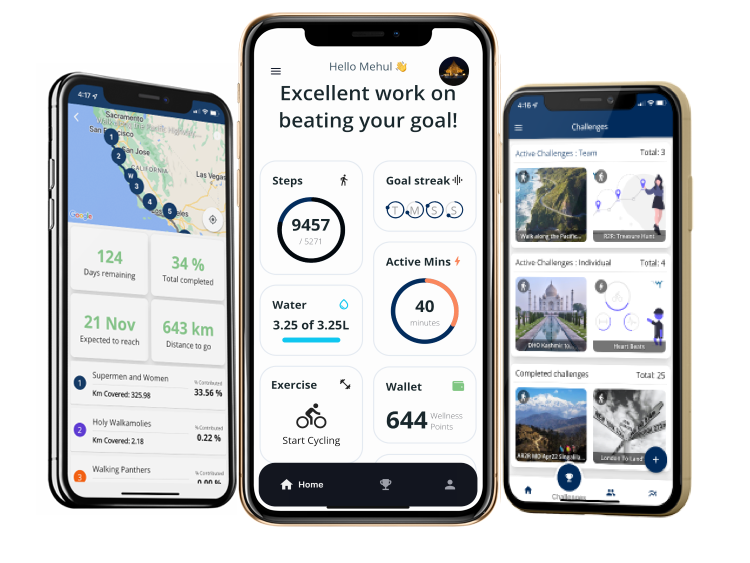
How does walking help? Does it help burn extra calories? I’m not a regular with cardio exercise, so then should I be regular with walking? Where do I start?
If you are asking these questions, or simply looking for a reason why you, or someone you know should walk more than they do – read on!
Walking has different health benefits for individuals with different fitness levels. Walking is free, easy to do for most of us and with the right planning & intent, can easily fit into our daily routine.
Walking regularly doesn’t get the street creds that something like running or swimming do and that’s because our definition of exercise needs to change. People tend to believe that hopping to the gym, lifting heavy weights, dieting (or starving) and tormenting themselves is the only way to get / stay fit and nothing else works. These may work for some, but for many of us, they won’t. As with building any habit, making small, consistent progress can make a lot of difference, and just walking a little more every day is not only sustainable, but hugely beneficial in getting / staying fit.
A professor at Duke University, William Kraus, the author of a 2018 study that links small bursts of exercise to longevity, told The New York Times, “The little things that people do every day can and do add up and affect the risk for disease and death.”
Quantifying the benefits of walking
Calorie burn
Walking helps in burning calories. Which can help maintain or lose weight. Actual calorie burn can depend on several factors:- Your walking speed, the distance covered, terrain (you’ll burn more calories walking uphill than you’ll burn on a flat surface), and of course, your weight.
Calories burned walking
The most basic way to figure out how many calories you burn while walking takes into account your weight and walking speed:
| Weight | 2.0 mph | 2.5 mph | 3.0 mph | 3.5 mph | 4.0 mph |
| 130 lbs. | 148 cal. | 177 cal. | 195 cal. | 224 cal. | 295 cal. |
| 155 lbs. | 176 cal. | 211 cal. | 232 cal. | 267 cal. | 352 cal. |
| 180 lbs. | 204 cal. | 245 cal. | 270 cal. | 311 cal. | 409 cal. |
| 205 lbs. | 233 cal. | 279 cal. | 307 cal. | 354 cal. | 465 cal. |
These calculations are based on an hour of walking on flat surfaces, like sidewalks. Walking uphill for an hour increases your burn dramatically.
To put this in perspective, let us compare calorie burn for an individual weighing 180 lbs (~80 kg) and running at an average speed of 10 mins / mile for an hour. According to American Council on Exercise, this individual would burn up to 17 calories per minute and a total of 1000 calories over the hour. This would be equivalent the calories such an individual would have burnt walking 15,000 steps. The purpose of analysis here is that: running & walking are different activities, with different levels of sustainability for individuals and yet can possibly help you achieve similar levels of calories burns. Granted, you have to walk 15,000 steps to match an hour of running, but it is easier to pick up a walking routine and progressively increasing your steps & intensity.
| Your weight in pounds | Calorie burn per minute |
| 120 | 11.4 |
| 180 | 17 |
Boosts your energy level

Another benefit of walking is that starting your day with a walk gives you energy throughout the day. If you walk outdoors, that’s even more beneficial.
As per this research report, adults who walked for 20 mins outdoors in nature have more stamina and energy than those who walked indoors.
Another study found that walking up and down stairs for 10 minutes was more beneficial and energizing than a cup of coffee for those who had troubled sleeping experience.
Going for a walk rather than grabbing a cup of coffee when you’re feeling low and tired is a more effective energy booster and option as you’ll be able to get fresh air and walking increases oxygen flow in the body. It can also increase levels of cortisol, epinephrine, and norepinephrine. Those are the hormones that help elevate energy levels.
Improves your mood
Physiologically walking benefits more in the morning. Walking is underrated but it can help improve the self-esteem of a person, boost mood, reduce stress, reduce anxiety, reduce fatigue, ease depression symptoms or reduce your risk for depression
For better results, you must try walking at least 20-30 mins a day and make it a habit.
Boosts immune function

A study tracked 1,000 adults during flu season and concluded that people who walked for 30 to 45 minutes/day had 43 percent fewer sick days and respiratory tract infections.
Walking may reduce your risk of developing a cold or the flu.
Extend your life
Making walking a habit in your day-to-day life could extend your life. Researchers found that walking at an average speed in comparison to a slow speed shows a 20 percent reduced risk of death overall.
Tone your legs
We couldn’t miss this benefit, could we? Walking also strengthens the muscles in your legs – walking in a hilly area or on an incline on treadmill can strengthen those muscles even more.
Right, how to get fit & see the benefits of walking?
Walk with a goal in mind
The first step must start by writing down your schedule. Making a weekly schedule can help you stick to a plan. For example, Monday you start with normal walking, then brisk walking, then a longer walking, etc.
“Having a goal & intention can help achieve the goal faster”.

Skip normal terrain
Walking always has benefits, but if you choose a hilly route or street rather than a plain one then it will be more beneficial. It boosts your heart rate, increases activation of lower leg muscles, and increases calorie burning because your body is exerting more.
Walk companionship & social incentives
Walk companionship is a big driver in getting us to walk more. Group activities build strong bonds, are fun and people tend to skip less if they have made a commitment to their companion. It offers the best of both worlds: a good dose of regular exercise and time to have fun and build friendships with others.
At Walk With You, we can help you run fun, engaging & exciting team and individual step challenges for your business, family or group – just get in touch to see this in action.
Track your progress
You can’t improve what you don’t measure. Tracking steps make a huge difference in your routine. Behavioural science studies have found that having a goal, benchmark & tracker helps in improving end results. It holds you accountable for how much more effort you are putting and how much more you need.
Keeping a record of your daily steps helps you appreciate the progress you’ve made so far. Especially, reminders of your accomplishments, such as having completed 1000 steps will automatically uplift your mood and trigger positive feelings and confidence.
Comfortable walking shoes

Whether you’re running, walking, or gyming, a decent pair of shoes is a must. Investing in a quality shoe can help you prevent injuries like foot and ankle damage. Good shoes can lessen your step impact and cushion the foot from heavy landings and makes your exercise pleasurable & comfortable – which means you are more likely to keep at it.
That’s it. Walking is cool, has lots of benefits and you are more likely to sustain this as a habit than running. If you walk regularly, please share your walking stories, experiences in the comments.
If you are looking to build team engagement and get your employees active with a step challenge – get in touch 🙂


No responses yet